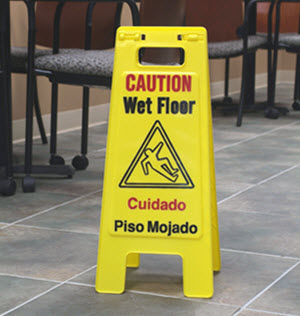Things We Need to Know About Hazard Warning Signs
Posted on 21st Sep 2017

There’s a lot more to hazard warning signs, also called safety signs or wet floor signs , than many of us realize.
For instance, there are specific guidelines as to the way they look as well as best practices as to where they are placed.
As to the placement of warning signs, OSHA specifications state that safety signs are to be installed “wherever there are specific hazards that, without identification could result in an accident or injury.”
So, what would these “specific hazards” include? Among them are the following:
- Floors or carpets that are being cleaned or have recently been cleaned
- Spills on a floor
- Areas where there is the potential for an accident—for instance, when light bulbs are being changed, or work is being performed overhead
- Wet or slippery outdoor walkways
- Areas that are closed due to cleaning potentially harmful chemical fumes
- An obstruction in a walkway
- When designating an area that should not be entered, inside or outside the facility
- The performing of grounds maintenance
Safety Sign Colors and Wording
Now let’s take this a step further. OSHA also has some regulations as to what colors (the sign as well as the words used on the sign) should be.
For instance:
- A sign that indicates “danger” must be red with white or black lettering.
- A “caution” sign must be in yellow, again with black or white labeling.
- Safety instructions, guidelines, or suggestions placed in a potentially hazardous area are to be in green with white or black lettering.
- Also, the wording should be easy to read and contain accurate information that is easily understood.
There is change afoot that will apply to hazard warning signs, however. With the Globally Harmonized Systemof Classification and Labeling of Chemicals (GHS) evolving around the world, pictograms are to be placed on signs. While the GHS is putting greater emphasis on pictograms to convey a message, the actual words used on safety signs to address potential hazards is still very important.
For example, a sign that indicates “caution,” might not be the appropriate sign to install in a situation where there is considerable risk of injury or even death. In its place, a more appropriate sign would read “danger.”
Here are the different hazard warning signs that should be installed, for instance, over a hard-surface floor indicating a potential danger:
Hazard may be present: If a potential hazard that could lead to an accident or injury is present, the appropriate sign to use would read “caution.” If, for instance, light bulbs are being changed in an interior walkway, the chances of an accident—while small—do increase. This calls for the use of a caution sign.
Hazard possible, but not probable: A more urgent message would indicate there is the possibility—but not necessarily the probability—of an injury or death. In such situations, a “warning” sign would be installed. A warning sign often is also posted when there is a Biohazard present, for instance in a storage room.
Hazard high probability : This is the most urgent of the three types of safety signs, and the word “danger” will be included. This sign should be used only in extreme situations in which people could be harmed. It is not to be used if the hazard involves only property damage.
We may also see a sign that just says “notice.” This might be posted outside a facility, for instance, to tell building users that floor or carpet cleaning work is being or was performed inside.
And while a safety sign with the words “emergency” may indicate a very serious situation, “emergency” is typically used to indicate procedural instructions such as “emergency exit” or “emergency eye bath.”
The last—yet very important—thing about hazard warning signs and safety signs: when the hazard is gone, and all is safe, it is very important to remove the sign. Unless it is an area where caution is ongoing, warning signs tend to lose their impact the longer they are installed in the same area.
For more information on safety signs and wet floor signs, contact a DayMark representative at 1-866-517-0490.


